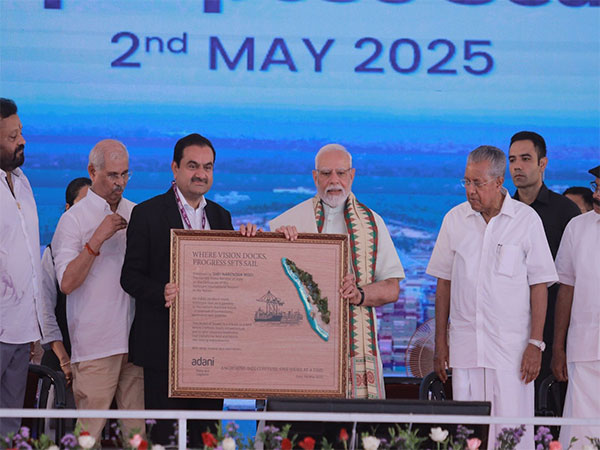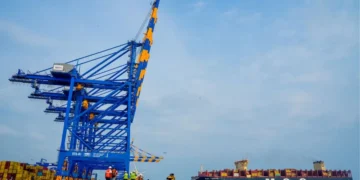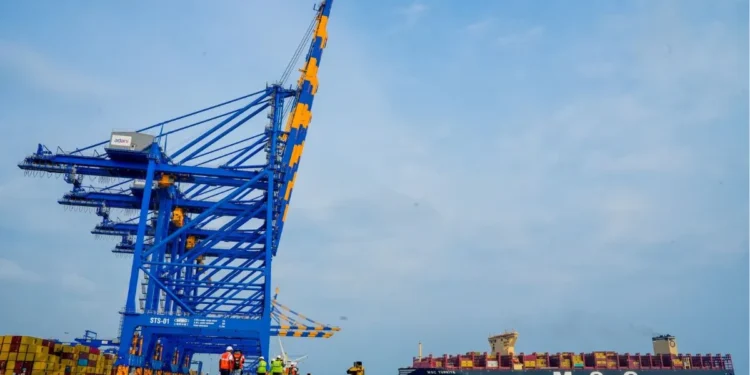PM Narendra Modi inaugurated India’s first deep-sea transshipment port at Vizhinjam, Kerala, on May 2. Strategically located near key international shipping lanes, the port serves as the Indian subcontinent’s only transshipment hub.

Prime Minister Narendra Modi has officially inaugurated India’s first deep-sea transshipment port at Vizhinjam in Kerala. Developed at a cost of approximately ₹8,900 crore, this state-of-the-art facility is set to position India prominently on the global maritime trade map.
The Vizhinjam International Deepwater Multipurpose Seaport commenced commercial operations in December. Since then, it has managed 285 vessels and processed 5.48 lakh Twenty-foot Equivalent Units (TEUs), including the MSC Turkiye—one of the world’s largest cargo ships.
Vizhinjam Port – Key Features
Vizhinjam Port is India’s first deepwater container transshipment hub, designed to handle the transfer of cargo containers between vessels en route to their final destinations. Strategically positioned near major international shipping lanes, it serves as the only transshipment port in the Indian subcontinent.
One of its standout features is its natural deep draft of approximately 20 meters, enabling it to accommodate some of the world’s largest container ships without the need for extensive dredging.
More from Explainers:
- Vizhinjam Port: How Modi’s Inauguration Could Transform India’s Maritime Trade
- Inside the CIA’s Hollywood-Style Plan to Recruit Chinese Spies
- Why Australian Politicians Are Embracing Chinese Social Media for Votes
- NIA Deploys 3D Mapping Tech in Pahalgam Terror Probe
Developed under a public-private partnership (PPP) model, the port is operated by the Adani Group, with the Kerala government holding a majority stake of 61.5%, and the Central government owning 9.6%.
In the initial phase, Adani Vizhinjam Port Private Limited (AVPPL) has completed the construction of a 3,000-metre breakwater along with an 800-metre container berth, according to a report by Fortune India.
At present, the port features 30 berths and has the capacity to handle one million (10 lakh) containers annually. The full project, which is being developed in four phases, is slated for completion by 2028–29. Once finished, the port’s annual handling capacity is expected to rise to 6.2 million (62 lakh) TEUs.
Situated only 10 nautical miles from the east-west global shipping route, Vizhinjam Port boasts a significant advantage over other major ports like Colombo and India’s Mundra Port.
The port in Kerala began its trial run last July, with commercial operations officially launching on December 3, 2024.
The Vizhinjam port was essential because India lacked a deepwater container transshipment port. As a result, nearly 75% of the country’s maritime trade was being transshipped through foreign ports like Colombo in Sri Lanka, Singapore, Jebel Ali in the UAE, and Salalah in Oman, since no suitable port in India could accommodate large vessels.
The reliance on international transshipment ports incurs significant costs and may lead to longer transit times. Domestic traders are required to pay an extra $80 (Rs 6,720) to $100 (Rs 8,401) per container, according to the Indian Express.
India is said to spend around $200–220 million (Rs 1,682–1,850 crore) every year on transshipment activities.
The Vizhinjam seaport has the potential to transform India’s maritime trade landscape. It will significantly elevate India’s position in global trade, improve logistics efficiency, and lessen the country’s dependence on foreign ports for cargo transhipment, according to government officials.
With a natural depth exceeding 20 meters, the port can accommodate Ultra-Large Container Vessels (ULCVs) such as the MSC Türkiye without the need for extensive dredging. This will enable India to save considerable costs that are typically incurred in deepening shallow ports.
The deepwater port is capable of handling massive “mother vessels” that can carry up to 20,000 containers. With its direct links to a national highway, railway network, and Trivandrum airport, it offers excellent connectivity, ensuring smooth and efficient cargo movement across India.
Starting December 3, the Gateway of India will shift 1,600 km south to Trivandrum. Currently, India’s share in global merchandise exports stands at only 2 percent. The primary issue lies in the inefficiency of the country’s logistics system, be it rail, air, or sea transport. However, the Vizhinjam International Seaport (VISL) aims to address this challenge, a senior official from VISL, who preferred to remain anonymous, shared with ThePrint.

The proximity of the port to major international shipping routes is crucial, with nearly 30% of global freight traffic passing through the shipping lanes south of the Indian peninsula, according to Business Standard.
In addition, the Vizhinjam port has created job opportunities for the local community. A senior official informed Indian Express that 755 individuals have been hired at the port.
Currently, around 67% of the workforce hails from Kerala, with 57% specifically from the Thiruvananthapuram district. Additionally, 35% of the workforce is from the local area. Notably, nine women from the local fishing community have been employed to operate large automated CRMG (Cantilever Rail Mounted Gantry) cranes. This marks the first instance of women operating such machinery in any Indian port,” stated the official.
According to ThePrint, Kerala is optimistic that the Vizhinjam port will attract greater investment and drive development in the state, encouraging Keralites working abroad to return home.
Once fully operational, the port is expected to enhance India’s competitiveness in global trade. As Prime Minister Modi highlighted, the port will “boost trade and commerce, providing a significant advantage to Kerala’s economy.”
Table of Contents
READ ALSO….India Blocks All Pakistani Imports, Direct and Indirect 2025















 Categories
Categories









